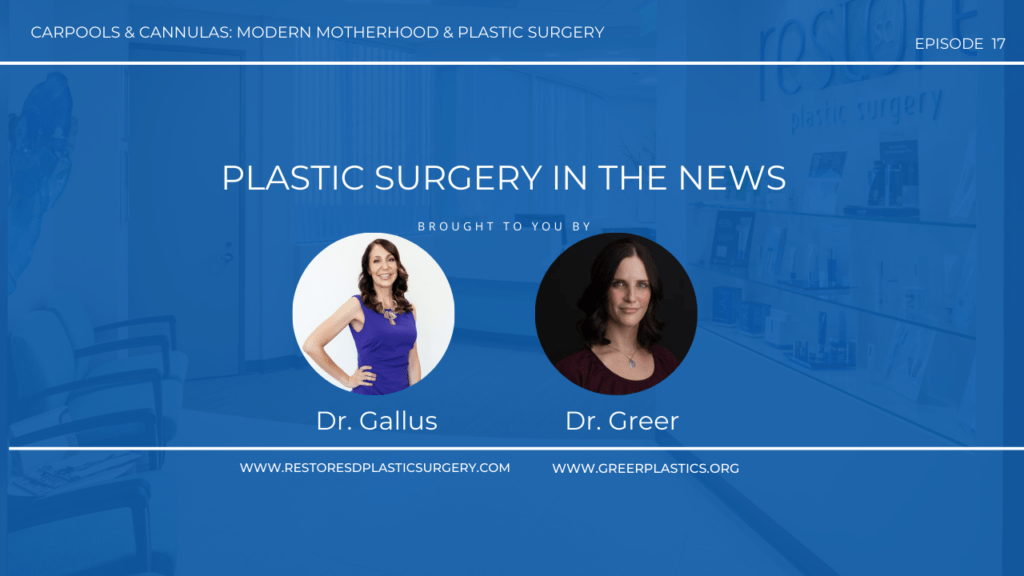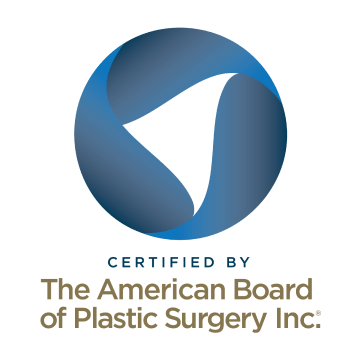In this episode of Carpools & Cannulas: Modern Motherhood and Plastic Surgery, Dr. Gallus and Dr. Greer give their take on Linda Evangelista’s CoolSculpting claims – what might have happened and what expected results are from CoolSculpting. They also discuss the recent article about the nurse who suffered a devastating consequence from lip filler – and why it isn’t a great idea to get filler from a “cosmetologist”.
Transcript
Dr. Gallus: Hi, everybody. We’re starting another episode of “Carpools & Cannulas,” hope you can join us. I have my dog’s in the background on the pullout couch. So hopefully she stays over there lounging. And Dr. Greer should be joining us shortly. Thanks for joining us. Oh, there she is. So, okay, we’ll get her on in a hot second. Hello there. We’re gonna talk about some exciting stuff this evening. Hey.
Dr. Greer: Hi. Can you hear me okay? I’ve got my… I am hiding up in my son’s room. So that’s working.
Dr. Gallus: Good.
Dr. Greer: We’ll see if they find me.
Dr. Gallus: They might. They might.
Dr. Greer: They might.
Dr. Gallus: I wanted to take my hair out because it’s been up all day for an OR and I’m like, “Oh my God, it’s crazy.” So I’m sort of putting it back.
Dr. Greer: I’ve got the headband to hide, you know, the greasy fluffy bangs.
Dr. Gallus: So we’re just gonna go with this. Whatever, it’s not about…
Dr. Greer: I think it looks very glamorous, and polished, and professional.
Dr. Gallus: It’s not about the hairstyle. So speaking of celebrity, people who worry about their appearance all the time, we are gonna hit the latest, greatest…
Dr. Greer: We’re hitting…
Dr. Gallus: …news. Yes. Breaking news.
Dr. Greer: Yeah. I did my research, I read the “People Magazine” article before we hopped on. So I could be fully informed.
Dr. Gallus: Right. The whole way through to the end? Did you read it all through?
Dr. Greer: Yeah, pretty much. I mean, I skimmed slightly, but yeah.
Dr. Gallus: Okay. So yeah, and then it’s been chopped up and made into, like, a bunch of other, like, more people commented on it. So for those that don’t know, Linda Evangelista, which the funniest part of this, I thought was the young people who don’t know who she is. And I’m like, “Oh, no.”
Dr. Greer: Yes. That’s gotta be hard for her. I mean, she’s 56, which is very young. But if you’re a super model, it’s probably like being a 56-year-old NFL quarterback. It’s just not gonna happen.
Dr. Gallus: Yeah, doesn’t happen. So she was a supermodel in the ’90s. I feel like famously said, “I won’t get out of bed…”
Dr. Greer: “I don’t get out of bed for less than $10,000 a day.” We could say that.
Dr. Gallus: I don’t think. I’d be laying in bed a lot, I guess.
Dr. Greer: Well, I mean, I didn’t say it would be effective to say it. Like theoretically, there are days that I would at least get out of bed.
Dr. Gallus: Right, right.
Dr. Greer: Maybe.
Dr. Gallus: So, anyway. So she’s famous supermodel. And then a few years ago now, she had CoolSculpting. Right?
Dr. Greer: CoolSculpting. Yeah, I think it was 2015, 2016.
Dr. Gallus: Right. Which we all know, you know, if… I’m so glad I’m not in LA dealing with celebrities on a regular basis. But, you know, you should not feel bad about yourself or your parents ever, because they all have extra help. So even when, you know, somebody like Linda Evangelista is a supermodel, she’s still getting CoolSculpting. So they’re all…they get an assist…
Dr. Greer: You know, I think it’s harder for them because they start off at this level of attractiveness. I mean, like you’re a supermodel, you’re the pinnacle of what women should look like, and then you still age. And when you hit 40, you still have trouble of staying thin. But the rest of us are kind of used to looking like crap sometimes and she’s…
Dr. Gallus: Right. Having an off day or yeah. Or you’ve already not eaten forever. So when your metabolism slows, now what do you do? Can you not eat? Like, what does that look like?
Dr. Greer: She had seven sessions of CoolSculpting, which is…
Dr. Gallus: Great. And you do do CoolSculpting.
Dr. Greer: We do. I mean, I actually just…
Dr. Gallus: Break that down…
Dr. Greer: …on my arms last week. It depends on how long the session is. You know, some people will do like abdomen and waist. But it’s generally like, you know, it could be… Because she had what? Chin, bra roll, inner thighs. I mean, that right there could easily be three sessions. And if you do two rounds, which is a normal treatment, we’re talking six sessions. I mean, that’s not absurd.
Dr. Gallus: Yeah, so that’s what I’m saying. Are they counting? Like, if you came back and did all of those areas seven times, that would be insane…
Dr. Greer: That would be insane. But if you’re just like in the office for a CoolSculpting session seven times over three areas, that’s… I’ve had seven sessions of CoolSculpting I’m pretty sure. Of course, when you’re on the machine, you’re like, “Oh, I found some fat. Hey, why don’t we [crosstalk 00:04:52] at 3 today.”
Dr. Gallus: That’s how I feel about the Emsculpt machine that’s at one of the offices. I haven’t used it yet but I’m like, “It’s just sitting there collecting dust. Like, I need to get on that.”
Dr. Greer: I would be hooked up to that thing.
Dr. Gallus: Okay. So she had not an egregious number of sessions, but three different areas. And then the concern is that she developed paradoxical adipose…
Dr. Greer: Adipose hyperplasia, PAH.
Dr. Gallus: Yes, PAH. Which means the area that is being treated, and i.e. is supposed to be frozen, and then the fat fairies come and take away the fat cells because it’s been frozen and they’re dead, that area, ironically, becomes fat.
Dr. Greer: Yeah, and it’s not like normal, soft, squishy fat. It’s like rubbery, hard fat. It’s not common, though. I mean, people who do a ton of CoolSculpting say it’s almost never seen. I think the quoted numbers are like what? One percent or something. So it’s more than we’d like, but not real common. And I think it’s less common now with the newer applicators, which are lower suction. It was most common in the abdomen, especially with a very large applicator. I don’t know. I mean, since we don’t really know why some people are prone to it, it seems not unreasonable that you would develop it in all of the areas you were treated, if your body was prone to that response. But it is treatable with liposuction. You know, it’s kind of like, oh, if that’s what your body does in response to CoolSculpting, it kind of makes sense that it would do it everywhere you’re treated.
Dr. Gallus: Yeah, in all the areas. Okay, all right.
Dr. Greer: I mean, I have no, like, actual information to base that on. But it seems logical.
Dr. Gallus: I mean, I think when it first came out, and there was…when PAH was first recognized as a potential complication early on, I heard it presented at a conference. But actually, someone asked a question, wasn’t even part of the presentation. They sort of got like, “Oh, no, that never happens.” I mean, this is a decade ago, which is, you know, how it was, right? And then they were like, “No, no, no, it does happen.” Then it was like an acknowledgment that it can happen in 1% of the cases, and that it’s difficult to treat. And they were trying to figure out was it, you know, a certain ethnicity, or a certain body part, or a certain demographic, or a certain…
Dr. Greer: Or applicator type.
Dr. Gallus: Right, yeah. And so the thing is, it’s a moving target. Because I know the applicator times, those aren’t…I mean, some of that’s variable on who’s doing the treatment, correct? Or is that pretty standard?
Dr. Greer: No, they’re set by the machine. It varies by body part and applicator. So it’s longer, I want to say, under the chin and for the smooth applicator, but that’s not something you can adjust at all. Like, the suction strength and the settings, like, it’s just plug and play.
Dr. Gallus: That’s good. Okay. So yeah. So I do understand, though, and maybe I’m wrong, I’ve gotten the impression that there is some variability in the treatment, just depending on the technician. So what would a good technician do?
Dr. Greer: It’s really more about the placement of the applicators and being able to see like, okay, here’s the high point in the fat. This is where we need to put the applicators for good treatment. So like at my office, I see all the consults. But, you know, there are only so many different ways to put the applicators on. So I will, like, draw out a very basic plan. But my technician Christie, who’s freaking amazing, she loves, like, eyeballing because, you know, she’s done my arms for me a few times, and I’ve watched her do so many treatments, and she just has a great eye for like, here’s the high spot in the fat. This is where I need to center the applicator to get the best contour. Because you can leave indents. I’ve seen that happen too. You know, when people say it’s not effective, yeah, it is. There’s an indent. And that sucks. Yeah.
Dr. Gallus: My dog’s bored by the conversation, by the way. He just left.
Dr. Greer: Oh, that’s okay. So yeah, I mean, you do want somebody who does a lot of CoolSculpting and really has a passion for it. But the actual, like, putting the applicator on, it’s pretty simple. It’s more like placement of it and getting everything hooked up without losing suction.
Dr. Gallus: Okay. All right. So now we’ve established it’s pretty straightforward. No one’s super clear on what causes it. But then the next part is she developed PAH, which is extremely unfortunate. And most people… I mean, the problem…not the problem. The thing with cosmetic procedures is you’re trying to improve something that’s normal, right? So you didn’t really need to do it, to start with. And so when stuff goes sideways, it…
Dr. Greer: It’s worse.
Dr. Gallus: …germinates a ton of feelings for everybody involved, right? Because you…
Dr. Greer: Yeah, it’s not like, “Oh, we closed a big dog bite and the alternative was leaving the big dog bite.” Like, the alternative is not having CoolSculpting and just looking like a normal 56-year-old, who’s maybe a little overweight.
Dr. Gallus: Or even liposuction. You know, there are so many other alternatives that you didn’t have to do it. And so now you’re stuck with this result you’re unhappy with. So I can imagine, you know, the degree of unhappiness. But then Allergan, who owns CoolSculpting…
Dr. Greer: Zeltiq. Yeah, who owns CoolSculpting.
Dr. Gallus: …you know, offers to send you to an expert to do liposuction to correct it. And from reading the article, she refused that expert because you have to sign an NDA, blah, blah, blah. That’s never happened. We’re fixing it.
Dr. Greer: Which that’s pretty standard in the cosmetic surgery industry. Like, if you give people a refund for something, like, they sign an NDA. It doesn’t mean there was anything shady going on with Allergan.
Dr. Gallus: No, absolutely. Yeah. So they’re just saying, “Yeah, we’re gonna fix this, you know, maybe don’t blast me social media over it.” So she didn’t go to that person, went to somebody else for correction, and then had two different rounds of liposuction. Which is…
Dr. Greer: See, that’s the weird part. Because I don’t understand, like… Because what she says is that she had lipo and then it returned, not that the lipo was in a good result. And mind you, it’s not like I have treated her, we’ve never seen her. I got to look at her inner thighs and tights in the “People Magazine” spread. But it doesn’t make sense to me that it would come back after liposuction unless you have more CoolSculpting or something in the interim. Like, what would the stimulus be? I’m not saying it didn’t happen that way. I just I like to know the physiological basis for that. That’s kind of weird.
Dr. Gallus: So liposuction is kind of a…once you’ve taken those fat cells out, we’ve talked about this…
Dr. Greer: They don’t come back. Yeah.
Dr. Gallus: They can’t come back, you’ve actually suctioned the fat cell.
Dr. Greer: I’ve done a case study. I had lipo and then got pregnant and gained weight, just so I could tell you guys. But I had CoolSculpting, too. And it’s the same thing, the fat cells are gone.
Dr. Gallus: Right. Fat cells are gone, the remaining fat cells are going to get bigger or smaller if you gain weight. So you could, you know, lose weight, have the liposuction, gain weight, and then those areas, I guess, come back disproportionately. It usually doesn’t…
Dr. Greer: Yeah. I mean, because we’ve all seen people who have had lipo 20 years ago and gained weight. I see children behind you. And what happens is you gain weight, like, in the same proportions that your body’s in now. So if your stomach’s flatter, it’s still going to stay relatively flatter compared to the rest of you.
Dr. Gallus: Right. Because there are fewer fat cells. Yeah.
Dr. Greer: So I don’t know how it came back. I mean, that part is a little weird, unless maybe the first treatment just wasn’t effective. Because that fat, from what I’ve heard, is pretty stubborn, and rubbery, and tough. I’ve only done one case, and it fit all of those criteria. It wasn’t my patient, FYI. I didn’t do the CoolSculpting. But, you know, it makes me wonder like maybe it just wasn’t an adequate treatment because you have to be more aggressive than just standard liposuction to get that stuff off.
Dr. Gallus: Right. And it’s like repeat liposuction, which I think I’ve seen more frequently people have liposuction elsewhere, and then, you know, it’s a few years later, and they need/want more. And it’s a little bit harder going back in there. And so there are other tools, I do safe lipo, we can add the VASER, some other kind of aggressively treat that. So yeah, it’s a little interesting that despite all of that, she’s still unhappy with her appearance, which is…
Dr. Greer: Right. And, you know, I mean, from the “People Magazine” photos, so they show a lot of shots of her face, she looks great. There’s no submental lipodystrophy here, it is smooth as glass. She’s got a pretty darn nice jawline for a 56-year-old too. So I don’t know if that was a problem. But then they show like her bra roll. That was tough. It looks like just that normal skin that everyone gets after age 40. Like, that’s an area that just collects skin, and it didn’t have that… So like the PAH, it’s like somebody stuck a block of butter to you. Like, it’s very discreet. It’s like a little brick of fat. And it didn’t have that look. And then her inner thighs, they just showed in leggings. And I don’t know. I mean, I see a lot of inner thighs that look like that in your normal woman.
Dr. Gallus: I feel like a lot of people are like, “That’s what my bra roll looks like and I haven’t done anything.”
Dr. Greer: I had that thought, for sure.
Dr. Gallus: “I can do that for free.” Yeah. Yeah, it’s a little… And her brow lift seems on point or not that I know…
Dr. Greer: Oh my God, I want that. Can I come see you and we’ll just…?
Dr. Gallus: We’ll just do it?
Dr. Greer: Maybe not that much. Just a little one.
Dr. Gallus: Oh, no. Ours is intense.
Dr. Greer: I look at my mom’s eyebrows and I’m like, “Better get that done sooner than later.”
Dr. Gallus: Don’t wait. Yeah. So it’s sad. It’s interesting that she’s taking it to social media. It’s a little…
Dr. Greer: Yeah. Well, and taking it to court. I mean, that’s expensive, unless it’s all a publicity move because she has gotten more coverage in the last two months than probably the last 10 years combined.
Dr. Gallus: Right. Yeah. I never understand people’s ulterior motives to be in the limelight. Oh, well.
Dr. Greer: Yeah, yeah. So I don’t know. I mean, parts of her story don’t quite make sense. But it’s probably just because we don’t have all the information.
Dr. Gallus: Yeah, I agree.
Dr. Greer: Yep. And I think the whole disfigured part is more…I’m gonna go out on a limb and say it’s really hard from going to one of the most sought after models in the world to like looking like an average 56-year-old. I mean, a gorgeous 56-year-old, but, like, her overall physique is more normal.
Dr. Gallus: Is age-appropriate.
Dr. Greer: Yeah, thank you. Age-appropriate.
Dr. Gallus: She’s not a J.Lo or somebody who’s, like, been frozen in time or is filtered or I don’t know.
Dr. Greer: Yeah. I feel like those people, like, bathe in the blood of virgins where they have, like, a deal with the devil. I mean, or there’s just a lot of airbrushing.
Dr. Gallus: Yeah, I think there is a little bit of that. And maybe they sleep in the freezer at night. I can’t figure it out.
Dr. Greer: Yeah, I mean, like, I hope I look that well preserved.
Dr. Gallus: Oh my God. All right, well, so not solving any crimes here. But the next…
Dr. Greer: But that’s our take.
Dr. Gallus: That’s our take on Linda Evangelista. Lots more questions than answers. And I guess we’ll see how that… I’m gonna guess at the lawsuit, we never get a conclusion. We’re gonna have all these work, and then they’re gonna settle out of court and it’s going to be non-disclosed, and everyone’s gonna have to not say anything about it.
Dr. Greer: Yep, probably.
Dr. Gallus: Pretty much. Okay, cool. So you sent me the article. I hadn’t seen it yet.
Dr. Greer: Yeah, that one. Where did I see it? Somewhere on Facebook. And it was in the “New York Post,” which is not always a great source of, like, total fact. And you kind of love the headline like, “Nurse almost loses half of her face after a botched lip filler,” which was a tad dramatic. So the story, if you read it, what happened is a vascular occlusion. And that is a risk of filler regardless of whoever’s doing it. Around the mouth, you have your labial arteries, labial for lip, and the filler went into the one on her right side, and the whole area turned dead white. Like in the office, she took a picture of it and it is classic presentation. The problem is it wasn’t recognized. In fact, she said at the time, like at the time of injection, there was a lot of resistance and it hurt. Yeah, and that right there is a warning sign. The first problem with this article is she went to a cosmetologist. They’re not licensed in New York to do…or any state that I know of, to do injections or anything invasive. And it’s weird to me that, like, a medical professional would go to a cosmetologist for injections. But I don’t know, I’m sure they were cheap.
Dr. Gallus: Or like it was inexpensive.
Dr. Greer: Yeah, probably. Yeah. So that right there, she’s not with a licensed provider or… And even then, I see children, you have to be really careful about the training. My nurse practitioner, when I trained her back in April, and she’s amazing and has been with me for years. So she told me that she was talking to friends who had trained for fillers, and they would pay like $3,000 for a weekend course and there would be one patient, and, like, they would each get half a syringe of filler to inject. And that was the total training. Chelsea did legit 12 to 15 syringes of filler, and just as many toxin patients under my direct supervision, and then started treating patients with me immediately available. Like, I mean, she had… What is that? I can’t do the math, like 30 times the training.
Dr. Gallus: Right. It was a quick weekend course. Like I took an advanced course one afternoon, like several years ago, just because. And I thought that it was going to be…it was an advanced injectors course. So I forget what rep was, you know, helping me take the class. And so I just assumed it was other plastic surgeons and dermatologists, and I was the only…
Dr. Greer: It was just like random people.
Dr. Gallus: It was like, “I’m an ER doctor and I like to do this on the side. I’m a pediatrician. I’m a family practice person.” I was like… It was worth it because Steve Yolen, who’s actually an excellent injector in Orange County, was there and one of the trainers. And it was worth it just to see him, you know, teach in person. But nobody else there had any business doing injections after a four-hour evening course. It was crazy. And then…
Dr. Greer: Yeah. I mean, there’s so much facial anatomy you need to know. And like even now, my understanding of facial anatomy is changing and improving. And, you know, the specialties like family med, and OB, and ER, they don’t do as much training as plastic surgeons, and facial plastic surgeons, and dermatologists do on that to start, which…I mean, they’re doctors. Of course, they’re capable of learning. But, you know, like, more time is needed is what we’re saying, and more training is needed. So she went to this unlicensed, who knows where she learned stuff person, had an immediate problem, and this is the most serious risk that can happen, short of vascular injection into one of the retinal arteries, in which case you’re blind and there’s nothing to do there. But the other issue with it is classic symptoms, easy to recognize, and it wasn’t treated appropriately. Because vascular occlusions… Yeah, I mean, she literally was like, “It’s fine. Bye” So, this poor…
Dr. Gallus: You know, massage, right, didn’t she tell her to massage or something?
Dr. Greer: Yeah, quick massage, maybe some ice. So this poor woman goes to the ER like two days later, and to their defense, most ER doctors don’t see this either. So they thought, “Oh, it’s swollen. We’ll inject some steroids.” It probably didn’t hurt it, but it’s not the right treatment. What you do is you immediately inject hyaluronidase to break down the filler. You put topical nitroglycerin on to improve blood flow, you give an aspirin, and then you hook them up with hyperbaric treatment. And she did have the hyperbarics, but at that point, it was more of a wound care management. This vascular occlusion could have been most likely totally reversed and cause no problems.
Dr. Gallus: There was one office today, not my office, in my building. Because somebody came back to my office and said, “Hey, whoever is wondering if they can borrow some Hylenex.” And I’m like, “What do you mean borrow?”
Dr. Greer: “Are you gonna give it back? Or do you need like four or eight?” I mean, you need a lot.
Dr. Gallus: Right. So it’s like, “Did they say how much they needed?” And the person that had been sent, the messenger didn’t really know. So I was like, “What’s the story?” Because I keep Hylenex for vascular emergencies, haven’t had, but also I have people who come in and they’re like, “I went to LA, or Mexico, or wherever and my lips look insane.” You can reverse stuff. Or you can touch up if somebody doesn’t like it. So I keep a vial for touch-ups or reversing things. And then you keep some for vascular emergency. So I went out front to ask the guy, “Which category are we in here?” And he was like, “I think we need a lot because we used all of ours already.” And it’s got like a blue here. And I was like, “Okay, here’s four, okay, four more. Let me know what you need.” And then Dr. Taylor, who’s in my office, office shares with me, she has an ultrasound that she’s had for probably like five or six months now. And so she’s like, “I can go up there and ultrasound it, if they want.”
Dr. Greer: I’ll have to remember that. I have an ultrasound too.
Dr. Gallus: Yeah. She was like…I go, “Oh, I’m sure they have one there.” So it’s an experienced injector. And she did go up there and they didn’t have one. And she was… So they had already kicked off the appropriate treatment. And I think it was the labia artery occlusion. They were already reversing most of it. Like, upper lip went white. This area was going white. I know. And then…
Dr. Greer: I mean, these are, like, the things that keep us awake at night, if you’re wondering. This and, like, nerve issues after facelifts are what I think a lot about.
Dr. Gallus: Yeah. So she ultrasounded it and you could see facial artery was wide open, labial artery was wide open. Like, by the time that it’s [crosstalk 00:23:06] for a couple of hours and brought her back again, warm compresses, all the things you mentioned. And now you can see all of that is wide open just with blasting it. And then I’m sure she’ll come back again tomorrow and check it again. But it happens even with a professional it. You could see on her anatomy, she had, you know, a crazy maze right around here. Which then, you know, everyone’s anatomy…
Dr. Greer: It’s one of those things and you do enough filler it will happen, but the key is recognizing it and having everything on hand to treat it. Like we have our little emergency box, the protocol taped to the cabinet.
Dr. Gallus: Same thing. Who’s the hyperbaric person? Who’s the ophthalmology on call? I feel like all of that stop evil spirits to some degree. And then I remember I said, I was talking to Dr. Taylor and I said, “I just don’t understand how at all these med spas, like, doesn’t even…people just be injecting, like this cosmetologist in New York.” Like, it’s fine. Just massage it out. You’re like…
Dr. Greer: Well, it’s like they don’t know. They don’t know that that can happen or that you can make somebody go blind from filler. I mean, there are areas like up here in your glabella. This is not a common area to inject because there are some big vessels right here, and you can get necrosis. Like, I’m the only one in my office who injects there. My nurses are like, “No thank you. Do not want to.” And it’s not an area we need. But, like, they read up on anatomy, they’re always sharing articles with me. They’re like, “Hey, look.” Or we’ll all share articles with them. Like there was a new one recently saying that drawing back on the syringe to look for bleeding was not actually helpful in preventing. So we’re constantly talking about strategies to avoid it. Yeah, and that’s the key.
You want people who… Like, I think nurse injectors can be amazing, but you need to make sure that, A, they weren’t trained on a half a syringe of filler on a weekend course. B, the person who oversees them is experienced because they can have a doctor overseeing them who doesn’t know anything about treating vascular occlusion, and then that’s not helpful. And C, that they work tightly with that doctor, and they don’t just go cowboy up and do some crazy shit. I’m dropping swear words tonight. Sorry.
Dr. Gallus: Totally agree. Yeah, it’s crazy. You just have to make sure that you have somebody who’s experienced who knows how to treat complications, otherwise you shouldn’t be doing if you haven’t…if you don’t know how to manage the complications, I don’t really think you should be injecting.
Dr. Greer: Yes. There are so many treatments. Do you remember when that gastric balloon thing came out that you swallowed? And it filled up your stomach and it was supposed to act like a gastric sleeve. And they sent me this literature as if I was going to do this in my office. I’m not a general surgeon. I can’t open up somebody’s stomach and repair the obstruction I caused by having them swallow this thing. So I’m not touching that.
Dr. Gallus: That got presented at a Hot Topics conference. And I texted someone who is a general surgeon, and I trained in general surgery. And I was like, “Have you heard of this?” And he’s like, “Oh, that’s a nightmare. And why are you guys talking about it?” I’m like, “I don’t know.” You know, sure it’s easy to put the little thing down, you know, swallow this and you get a balloon in your stomach. But then what? How do you get it out? Are you an endoscopist? What if there’s a problem like oh…
Dr. Greer: And the reps are like, “Oh, what do you mean?”
Dr. Gallus: Just thinking out loud here, there might be a downside. Yeah, I feel like it’s already off the market. Because and true that, somebody was putting, like, more than one balloon in and just more is better kind of thing. Yeah.
Dr. Greer: Oh, heavens.
Dr. Gallus: Yeah. And I guess there’s someone on TikTok, too, also making the rounds with her filler disaster for my teenagers. But she had filler injected into her lips, no complication, but then went out and had a few drinks. And so when she woke up the next morning, her lips looked insane. Which is a known issue. So no alcohol right before, and no alcohol right after.
Dr. Greer: I’ve definitely broken that rule.
Dr. Gallus: I know. I’ve definitely…
Dr. Greer: There’s a difference too between a glass of wine and four shots of tequila at a bar also in terms of inflammatory levels.
Dr. Gallus: And everybody has different tolerances for allergens. You know, like maybe you’re sensitive to alcohol, maybe you bruise easier when you have… You know, it just depends on the person, but it’s definitely a potential downside. I bruised very poorly after doing headstands with my kids the evening of lip injection.
Dr. Greer: Weird. So do I.
Dr. Gallus: I know.
Dr. Greer: Yeah, I definitely, depending the product use too, there are sometimes I’ve done lip filler, and the next day I just look like a duck. I tell everybody, I’m like, “Prepare to not be presentable in public tomorrow. It’s gonna look awful.” And then it’ll go down.
Dr. Gallus: And then it’ll go…
Dr. Greer: And then when they wake up looking like Daffy Duck, they’re not panicked, at least not very much.
Dr. Gallus: Right. Yeah, I’ve never had that problem until the last time I injected my lips. Probably a year ago now. And I woke up the next… I looked great. And then the next day, I was like, “Oh, okay. Oh, that’ll go down.”
Dr. Greer: Yeah. And you go to the grocery store, you’re like, “It’s fine. I’m going through this” But now we just put on masks. It’s amazing.
Dr. Gallus: Right. Yeah, we can definitely get through that period of time. So cool. Well, if anybody has a suggestion for things we can talk about next time, hopefully there’s no celebrities between now and a couple of weeks from now, we’d love to hear it. DM us.
Dr. Greer: Yeah, absolutely. And we’ll come up with something to talk about. We always do.
Dr. Gallus: Yep.
Dr. Greer: Maybe we could talk about thigh lifts. We haven’t talked about those yet. Have we?
Dr. Gallus: Oh, yeah, we can. I have one coming up, actually. So yeah, let’s do that. The thighs.
Dr. Greer: Cool.
Dr. Gallus: Maybe it’s what Linda needs.
Dr. Greer: I mean.
Dr. Gallus: It wouldn’t hurt right there.
Dr. Greer: No, it wouldn’t hurt. Awesome. I don’t have to tell you how I started doing my thigh lifts like the Hunstad arm lift, like the brachioplasty…
Dr. Gallus: Oh, yeah. I think that’s…
Dr. Greer: …awesome.
Dr. Gallus: I think that those thigh lifts instead of… But, you know, and the person who needs the long lap, that’s a great idea.
Dr. Greer: It helps.
Dr. Gallus: Yes, lots to chat about.
Dr. Greer: All right. So good to see you.
Dr. Gallus: Yeah, it was good to see you. Bye.
Dr. Greer: Bye.
About Restore SD & Dr. Katerina Gallus
As the Director of Restore SD Plastic Surgery, board certified female plastic surgeon Dr. Katerina Gallus has over 15 years of experience helping San Diego women enjoy head to toe rejuvenation with face, breast and body procedures. After a successful career as a Navy plastic surgeon, Dr. Gallus founded Restore SD Plastic Surgery with the intention of creating a welcoming space for anyone seeking cosmetic enhancement.
Restore SD Plastic Surgery offers popular facial rejuvenation procedures like facelift & neck lift, facial fat grafting, and eyelid lift; breast augmentation with implants, breast lifts or breast reduction; body contouring procedures such as tummy tuck, liposuction, mommy makeover, and Brazilian butt lift (BBL), as well as aesthetician services, BOTOX, injectable fillers, and laser treatments.









